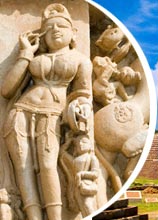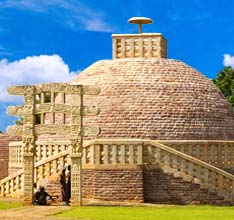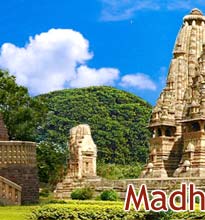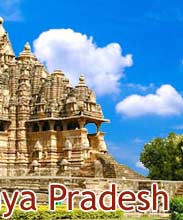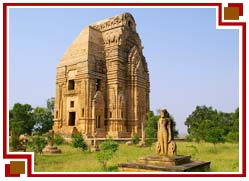 Located
at a strategic site, in the Grid region of Northern India, Gwalior is a
celebrated city of Madhya Pradesh. With its white sandstone mosques,
studded temples and soaring buttresses, the place recounts the majesty
of the Indian soil. A chronicler of the rise and fall of many dynasties,
the place still retains its antique vaudeville in its art and
architecture. Tourists from all over the world trot to the place to get
a glimpse of its fine enmeshing of antiquity and modernity. Boasting of
a rich historical saga, Gwalior is one of the most prominent tourist
destinations in Central India. This article will help you explore the
various places of tourist interest to be seen in Gwalior.
Located
at a strategic site, in the Grid region of Northern India, Gwalior is a
celebrated city of Madhya Pradesh. With its white sandstone mosques,
studded temples and soaring buttresses, the place recounts the majesty
of the Indian soil. A chronicler of the rise and fall of many dynasties,
the place still retains its antique vaudeville in its art and
architecture. Tourists from all over the world trot to the place to get
a glimpse of its fine enmeshing of antiquity and modernity. Boasting of
a rich historical saga, Gwalior is one of the most prominent tourist
destinations in Central India. This article will help you explore the
various places of tourist interest to be seen in Gwalior.Gwalior Fort
Positioned at a height of 100m above the main town of Gwalior, this staggering citadel dominates the skyline of the place and is acknowledged as the most impregnable fort in the whole of Central and Northern India. Built by Raja Man Singh Tomar, in the 15th century, its beauty has earned it the epithet of "The Pearl amongst Fortresses of India" by the Mughal ruler 'Babur'. The fort is girdled by sandstone walls and stretches over an area of 3 sq km. It houses three temples, six palaces and a large number of water tanks.
Man Mandir
This exquisite architectural specimen was also built by Raja Man Singh Tomar, between 1486 and 1517. Though, most of the ornamentations of this mammoth edifice have been corroded with time, traces of elaborate architectural trimmings and patterns still testify its glorious past. With decorative and colorful friezes and ornate rooms and stone screens, it exhibits a tasteful use of color, motif and patterns. The place houses the 'Suraj Kund Pond', where King Suraj Sen is believed to have been cured by sage Gwalipa.
Teli-ka-Mandir
This ancient edifice is a Pratihara Vishnu temple. Built in the 9th century AD, it towers at a height of 100ft. According to legends, the temple is so named as it is believed to be fabricated in the 'Telangana' architectural style. However, others believe that it is named after the 'Telis' (oil merchants) who built it. The structure displays a unique architectural pattern, with fine blend of Dravidian and Indo-Aryan characteristics. The roof of the temple is distinctly Dravidian, whereas the festoons and adornments have a strong Indo-Aryan appeal.
Saas-Bahu Temple
The Saas-Bahu temple dedicated to Lord Vishnu is also a major landmark of Gwalior. Built in 11th century, the name of the temple can be quite misleading. The temple, as many people believe, is not dedicated to 'Saas' (mother-in-law) and 'Bahu' (daughter-in-law). The name metaphorically and traditionally implies to two temples of different sizes adjoined to each other. The larger is more elaborately patterned with intricate artwork and attractive sculptures. There is also an ornamental lotus adorning its interior roof.
Jai Vilas Palace
Though Jai Vilas Palace is the current residence of the Scindia family; 35 of its palatial rooms have been converted into the 'Scindia Museum'. The architectural style of this imperial structure is dominantly Italian, with a fine blend of Corinthian and Tuscan architectural modes. Handpicked royal treasures and historical artifacts from different countries are displayed in the museum. The most striking one is a silver train, with cut-glass wagons and miniature rails, which chugged along dinner tables and was used to serve food to the guests.
Tomb of Tansen
The father of Hindustani classical music and one of the nine jewels of Akbar's court, legendary singer Tansen is buried in Gwalior. Built in the early style of Mughal architecture, the tomb of Tansen has a simple and pristine aura about it. The headstone is surrounded by beautiful gardens on all its sides. Apart from being an ancient monument, the site also underlines the rich cultural heritage of Gwalior. Every year in the month of November/ December, a national level music competition is held at the place, to venerate this great musician.
Mausoleum of Ghaus Mohammed
Located in the old town of Hazira is the mausoleum of Ghaus Mohammed, the 'Afghan Prince turned Sufi Saint' who helped Babur in annexing the Gwalior Fort. Built in the 16th century, this sandstone tomb is an exemplary piece of Mughal architectural adroitness. Built opulently in early Mughal lines, the screens of the monument have been carved using the pierced stone technique. Thus, these fine trellises look like delicate and exquisitely patterned laces. The beauty of the monument is also enhanced by the dappling gardens that surround it.

